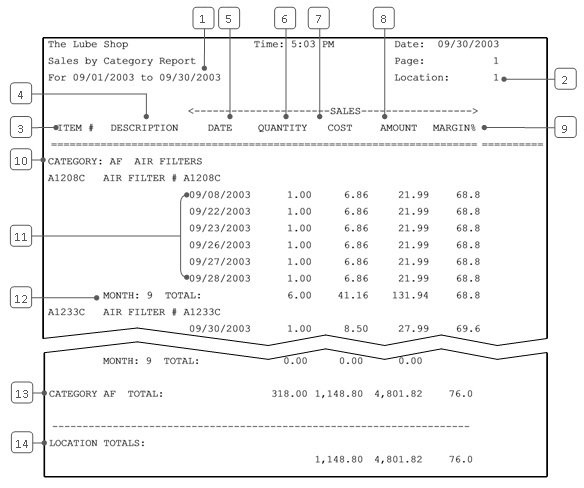The detailed Sales by Category Report shows the daily sales history of inventory items. The daily log reports total sales figures for an item for each reported day, including the following information:
The most important column on this report is the Margin% column, which helps you determine whether you are making an adequate profit from sales. For each item, there is a monthly summary for all the dates within each month on the report. For example, if you request the report for the last two weeks of a given month, that monthly summary includes data for those two weeks. Items are listed by category, and totals are provided for each category as well as the individual items. The last line sums up the total cost of goods, sales amount and profit margin for all items on the report.
| Note: | This report includes those items set up as parts (P) or motor oil (L) on the Set Up Inventory Items screen (1-7-5-1). Job Items (J) are not included on this report. For sales statistics on Job Items, you should set up those categories or items to print on statistics reports. |

Use the following steps to set up and submit a Sales by Category Report:
| Field | Definition | ||
|---|---|---|---|
| Category | Enter the particular category if you want to limit the information on the report. Leave blank to print all categories. | ||
| Entry Date | Type a date or a range of dates. Leave blank for all. | ||
| Item Number | Enter the item number or range of item numbers. Leave blank for all. | ||
| Print Time on Report | Printing the time helps you identify the most current report when the same report is printed more than once during a day. This field defaults to Y to print the time on the report. If you do not want the time to print on a report, type N. We recommend that you always print the time on a report. | ||
| Summary Only | This field appears for reports with both detailed and summary versions. Enter N to print the detailed report. which has a total for each item by day. If you choose summary, you receive a total for each item by date range. | ||
| Duplex | This field appears for terminals that have report type 2 enabled in the Set Up Printer Controls screen. Duplex mode enables printing on both sides of the paper.
|
||
| Number of Printed Lines per Page | This value tells the computer how many lines to print on each page of the report. A typical 11-inch page can contain up to 66 lines, but this field defaults to 60 to allow three-line margins at the top and bottom of the page.
|
||
| Total Number of Lines per Page | This field indicates the length of the paper in the printer. A typical 11-inch page contains 66 lines. Your system interprets a 0 or 66 in this field to mean that standard 11-inch paper is loaded in the printer. Because a 66 causes a form feed to take more time, accepting the default, 0, is recommended. | ||
| Print Report To | This field tells the computer where to send the report. The following list contains the different selections available for this field.
|
||
| Command Line Options | The line at the bottom of the screen contains commands to print the report and to save or change the report settings.
|
You can also set up this report on the Set Up Closing Processes screen (1-6-3) to print automatically as part of closing processes.
Report Contents
| Callout | Item | Description |
|---|---|---|
| 1 | Date Range | Range of dates for the report information. |
| 2 | Location | Location. This code identifies the location or profit center (such as a lube shop or car wash). |
| 3 | Item # | Identification number of the inventory item. |
| 4 | Description | Description of the inventory item. |
| 5 | Sales Date | Date for which sales are summarized. |
| 6 | Sales Quantity | Quantity of the item sold during the date range. |
| 7 | Sales Cost | Amount the sales quantity of the item cost your store. This amount is determined by the cost at which you received the items and the costing method you use (LIFO, FIFO, average or standard). |
| 8 | Sales Amount | Total sales amount for the item.
Sales Amount = Price * Quantity Sold |
| 9 | Margin% | Profit margin for the item, expressed as a percentage of the Sales Amount.
Margin% = [(Sales Amount – Sales Cost) ÷ Sales Amount] * 100 |
| 10 | Category | Category of items reported. |
| 11 | Daily Detail | Daily sales of the item. |
| 12 | Month | Number of the month during which the sales occurred. (For example, a 9 in this field indicates that the sales were in September.) Also, totals for the dates reported in that month. |
| 13 | Category Total | Totals for the category, along with the average profit margin. |
| 14 | Location Totals | Totals of cost and sales along with the average profit margin for the location. |
This report is most often used to supplement the summary Sales by Category Report because it provides a daily sales history along with the monthly history. This allows you to examine sales of an item or category in greater detail.
Related reports include the History by Type Reports, History by Item Reports, and Inventory Usage Reports.